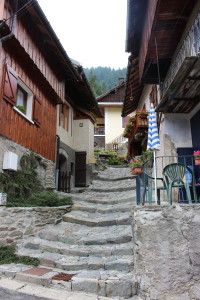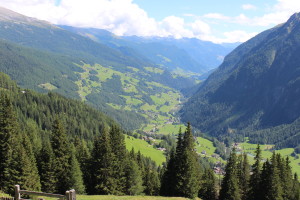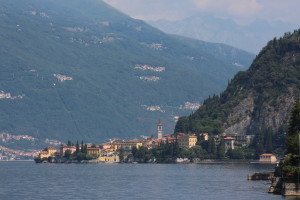August 30: Lately I have been wondering about pilgrimages. This is partly because I suppose I am on one of my own making, and partly because I am now near Pau, and as close as I will get to Compostelle, in Spain.
The St. Jacques de Compostelle route has interested me for many years. Not because I want to walk the route, but rather because it ties together so many fascinating and beautiful places in France (and elsewhere). On this trip I’ve encountered it several times already and reminders are everywhere in this part of the country.
 One of the “hubs” of the route is the cathedral in Puy en Velay. It’s built on top of a puy – essentially the core of a volcano after the cinder cone has eroded away. The cathedral sits atop it’s puy and can only be reached by walking up from the city below. The streets are steep enough to require steps every meter or so. The entrance to the cathedral is at the top of a flight of stairs so steep that they arrive in the middle of the church, not at the front door. You can see the altar from the bottom of the stairs, so it’s in front of you all the way up, and gradually revealed as you get closer. For a peasant in the middle ages, it must have been an incredible experience.
One of the “hubs” of the route is the cathedral in Puy en Velay. It’s built on top of a puy – essentially the core of a volcano after the cinder cone has eroded away. The cathedral sits atop it’s puy and can only be reached by walking up from the city below. The streets are steep enough to require steps every meter or so. The entrance to the cathedral is at the top of a flight of stairs so steep that they arrive in the middle of the church, not at the front door. You can see the altar from the bottom of the stairs, so it’s in front of you all the way up, and gradually revealed as you get closer. For a peasant in the middle ages, it must have been an incredible experience.
 To make the walk from your home, arrive in Puy and climb to the church. To be in a building unlike any you had ever seen before, soaring to the heavens on stone columns that couldn’t possibly hold it up. To see statues of the saints you had heard about in your own church for years, in colour and adorned with gold and jewels. To be surrounded by the power and beauty of the church and believe that accomplishing this task would bring you the blessings of your God must have been overwhelming.
To make the walk from your home, arrive in Puy and climb to the church. To be in a building unlike any you had ever seen before, soaring to the heavens on stone columns that couldn’t possibly hold it up. To see statues of the saints you had heard about in your own church for years, in colour and adorned with gold and jewels. To be surrounded by the power and beauty of the church and believe that accomplishing this task would bring you the blessings of your God must have been overwhelming.
What I find disturbing is that so many people seem to have lost the spiritual nature of the pilgrimage, and see it as a “bucket list” item to be “done”. Everest, Kilimanjaro, St. Jacques…. As I sat in the cathedral trying to make sense of it all, at least 4 “pilgrims”, identifiable by the scallop shell on their pack, came through and barely paused for a picture before they were on their way. Of course, the nature of a pilgrimage is ultimately personal, an perhaps they were reflecting on the spiritual side of what they had accomplished in other ways.
The outcome of my own pilgrimage will take some time to determine. I have come to understand some things about myself and the lessons I have learned much more clearly. Every day is a challenge – just like at home – and I know I have continued to grow by dealing with those challenges. But it will take the perspective of time and distance to really allow me to see the impact of my own pilgrimage.




![IMG_1278[1]](http://www.david-mckillop.com/wp-content/uploads/2015/08/IMG_12781-e1440344918794-200x300.jpg)











![IMG_0782[1]](http://www.david-mckillop.com/wp-content/uploads/2015/08/IMG_07821-300x200.jpg)





